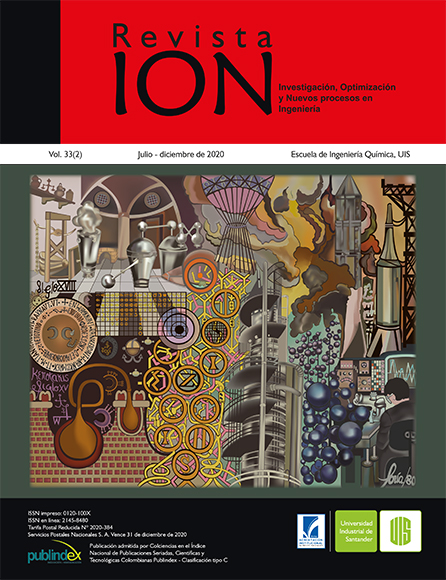Fuel microemulsions based on babassu oil (Orbignya martiniana)
Published 2020-12-31
Keywords
- Babassu oil,
- microemulsions,
- fuels
How to Cite
Copyright (c) 2020 Paulo Roberto Barros Gomes, Karlene Kelen Marques Mendonça, Cássio da Silva Dias, Victor Elias Mouchrek Filho, Hilton Costa Louzeiro, Fernando Carvalho Filho, Adeilton Pereira Maciel, Maria Alves Fontenele

This work is licensed under a Creative Commons Attribution 4.0 International License.
Abstract
In this paper we describe the preparation and physical-chemical characterization of microemulsion-based fuels, consisting of babassu oil, alcohol, water, commercial spirits and surfactants. Initially, we constructed the phase diagrams to obtain the conditions of maximum solubilization of the components. Next, we prepare the microemulsions from babassu oil, 40% ethyl alcohol, commercial spirits and isobutanol. We determined the kinematic viscosity, electrical conductivity and flash point of the microemulsions in accordance with the standards of the American Society for Testing and Materials. We observe in the diagrams the formation of two regions: a monophasic where the formulations exist as a visible phase in the form of thermodynamically stable microemulsions; and a biphasic one where the formulations are unstable and have two visible phases of imiscibility. The microemulsion systems had viscosities that varied between 6 and 4 mm2 / s. The flash point of the samples analyzed presented a value of 33 ºC, a value considered low when compared to petroleum diesel, 70 ºC. The conductivity for all systems was less than 1 μS / cm indicating the A / O classification for the microemulsions. The microemulsion systems presented a marked decrease in viscosity when compared to refined babassu oil, reaching values close to the viscosity of the diesel oil.
Downloads
References
[2] De la Rosa Ramos LR, Henríquez Montero E, Sánchez Tuirán E, Ojeda Delgado KA. Diseño y simulación de una planta para la producción de biodiésel a partir de Jatropha curcas L. en el departamento de Bolívar. rev. ion. 2015;28(1):73-85.
[3] Silva FC, Cavalcante KSB, Louzeiro HC, Moura KRM, Maciel AP, Soledade LEB, Souza
AG. Production of biodiesel from babassu oil using methanol-ethanol blends. Eclética Química. 2010;35(1):47-54.
[4] Cavalcante KSB, Penha MariaNC, Mendonça KKM, Louzeiro HC, Vasconcelos ACS, Maciel AP, de Souza AG, Silva FC. Optimization of transesterification of castor oil with ethanol using a central composite rotatable design (CCRD). Fuel. 2010;89(5):1172-1176.
[5] Santos AMCM, Araújo WS, Mendonça SJR, Nascimento UM, Maciel AP, Silva FC. Prospecção para obtenção de biodiesel empregando óleo de babaçu (orbigynia martiniana) e de óleo de soja (glycine max) utilizando líquido iônico como catalisador. Revista GEINTEC. 2017;7:3956-3969.
[6] Dias CS, Louzeiro HC, Silva FC, Maciel AP. Obtenção e Uso de Microemulsões Combustíveis de Óleo de Babaçu (Orbignya phalerata) em Motor do Ciclo Diesel. Rev. Quim. Ind. 2014;742:11-15.
[7] Barbosa DAB, Paschoal CWA, Louzeiro HC, Mendonça KKM, Maciel AP, Silva FC, Oliveira HP. Impedance spectroscopy investigation of the water-in-oil microemulsions formation. Colloids and Surfaces B: Biointerfaces. 2011;84(2):325-328.
[8] Santos DS, da Silva IG, Araújo BQ, Lopes Júnior CA, Monçã o NBN, et al. Extraction and Evaluation of Fatty Acid Compositon of Orbignya phalerata Martius Oils (Arecaceae) from Maranhão State, Brazil. Journal of the Brazilian Chemical Society. 2013;24(2):355-362.
[9] AOCS. Official methods and recommended practices of the American Oil Chemists’ Society Champaign: AOCS Press; 2009.
[10] Verma P, Sharma MP, Dwivedi G. Evaluation and enhancement of cold flow properties of palm oil and its biodiesel. Energy Reports. 2016;2:8-13. doi: 10.1016/j.egyr.2015.12.001.
[11] de Oliveira AG, Scarpa MV, Correa MA, Cera LFR, Formariz TP. Microemulsões: estrutura e aplicações como sistema de liberação de fármacos. Química Nova. 2004;27(1):131–138.
[12] Junior SB, Ketzer DCM, Gubert R, Andrades L, Gobo AB. Composição química da cachaça produzida na região noroeste do Rio Grande do Sul, Brasil1. Ciência e Tecnologia de Alimentos. 2006;26(4):793–798.
[13] Moretto E, Fett R. Tecnologia de óleos e gorduras vegetais na indústria de alimentos. Brasil: Varela; 1998.
[14] Ferreira MS. Formulação de combustíveis alternativos em sistemas microemulsionados
empregando óleos vegetais e derivados. alternative fuel formularization in microemulsified systems using vegetal oils And derivatives [Internet]. 7 de julho de 2006 [citado 23 de novembro de 2018]; Disponível em: http://tedebc.ufma.br:8080/jspui/handle/tede/933

